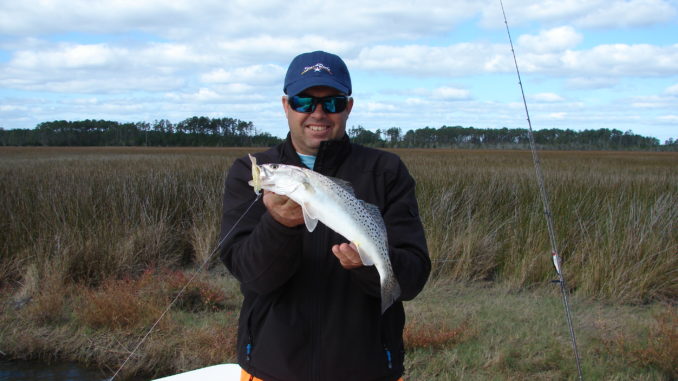
With live bait hard to find, artificials become staples for fishermen targeting speckled trout.
As he stowed the last of the fishing tackle, Capt. Noah Lynk of Harkers Island remarked that the tide was still a little low to get into several of the smaller creeks he intended to target that morning. He would first head to a couple of the more open marshes to see if the fifth day of sunshine and daytime highs in the 60s — unusually warm winter weather — had put the trout and red drum into a feeding mood.
The run from Lynk’s dock at Cape Point Marina to Middle Marsh was a little chilly, but one thing he said warmed the trip’s participants.
“I don’t know if they are feeding or not, but we just spooked a small school of drum,” he said. “If they are this far out in the marsh, they probably are, and hopefully so are the trout in this little deep slough we’re heading to.”
After rounding a few more bends, Lynk (252-342-6911) eased into area where an exposed oyster rock trailed off into the water. He passed out outfits with soft-plastic shrimp on light jigheads and kept one with a MR 17 MirrOlure for himself. Pointing at about a 45-degree angle off the bow, Lynk described a slough that started at the oyster point and ran past the boat.
“There is a little ledge for a few feet off the bank, and then it drops off pretty quickly out to about halfway out to the boat,” he said. “The current is running from the corner to us, so cast up into it and let it carry your shrimp down the slough. All you have to do is keep the line tight and twitch it off the bottom every few seconds to give it a little action.
“The bite will probably be light, just a little tick, so be ready. Most of the bites will be as the shrimp falls after twitching it, and by the time you feel it, he will already have it in his mouth. Give it a nice, solid hook set as soon as you feel anything. I think the trout will be on the bottom, but I’ll be working this lure that fishes higher in the water to see if they are suspended this morning. If I start getting strikes and you aren’t, we’ll switch you over.”
The shrimp made it through the first few drifts undisturbed, but finally, one of them came through the right place at the right speed and drew a strike. The rod bent, and the small trout was soon led to boatside where Lynk scooped it up in the net, then unhooked and released it.
The first spot produced a few more barely legal and not-quite-legal trout, plus a pair of mid-slot red drum, but with the tide better than halfway from low to high on the rise, Lynk decided to check another spot, running back into a small creek and staking the boat down again.
“Look up here,” he said. “See the current trail off that corner and how it comes out off the bank a little? Where it falls apart is where the water gets deeper. Usually the trout will be holding right in that area because the current sweeps any disoriented baitfish to them, and they are easier to catch. However, they may be as far back as a little behind the boat.”
The water was deeper and moving faster, and it was a couple of degrees warmer than the open marsh, so Lynk said to let the shrimp sink to the bottom before twitching it.
The fish took a few casts to warm up to the soft-plastic shrimp, but they soon began pecking at them. Several strikes weren’t felt until the line came tight as trout tried to swim away holding the shrimp in their mouths. A few trout were hanging back, but most were caught after the first or second twitch of the shrimp, within 10 feet of where the swirl fizzled out. These trout were almost all of keeper size, and some were 18 to 19 inches long.
After a while, the tide stopped running and the bite shut down. Lynk said that is usually the pattern with specks, and instead of staying put and waiting for the tide to fall, he moved to where it was already falling, off a point in a wider section closer to the creek’s mouth, with a trough that ran along one side of the point into the channel.
The action began immediately. On his first cast, Lynk reared back to set the hook, and after a back-and-forth battled that lasted a couple of minutes, he coaxed a nice black drum into the net. Only a few trout were caught, but red drum and black drum were repeatedly fooled by the artificial shrimp.
After a while the drum action slowed, and Lynk decided to try the North River Bridge before calling it a day. The water was deep enough there that Lynk had to use an anchor, and once the boat was secure, things began immediately. One of several fishermen wading beside the bridge landed a nice speck, while Lynk switched to the MirrOlure to get it to sink in the deeper water, and he hooked up immediately. Once the trout tired, Lynk carefully eased it back to the boat, where it joined the others in the cooler.
Several more specks, a red drum and a black drum liked the fake shrimp drifting downcurrent at the bridge. A couple of the larger ones joined the fish in the cooler to be the honored guests for dinner, and the others were released.
After a while, Lynk looked at a heavy cloud line pushing in from the northeast on the leading edge of a front and said, “Let’s go ahead and get out of here before the wind blows up or we get caught in the rain. The fishing has been pretty good and we’ve caught some fish. There’s no need to get wet and cold trying to catch a few more.”
DESTINATION INFORMATION
HOW TO GET THERE — US 70 and NC 24 will lead most people in North Carolina to Morehead City, and US 70 continues east to Harkers Island Road (CR1332) and Harkers Island. Cape Point Marina and several other private marinas with fee ramps are on that road; A free N.C. Wildlife Resources Commission ramp is on the mainland side of the bridge that leads across to the island.
WHEN TO GO — Many fishermen consider November and December to be the prime months for specks, but with the warmer falls of recent years, January has also become an excellent month to catch them. A bonus is fewer fishermen and boaters to possibly be in the way or disturb the spot.
TACKLE/BAITS — The standard for trout fishing is a light-medium to medium action, 61/2- to 71/2-foot spinning outfit; some fishermen prefer baitcasting outfits, but spinning outfits are easier for the average fisherman to cast and limber enough to prevent pulling hooks out of soft-mouthed trout. During January, mud minnows are the only live bait generally available. For artficicials, a 3-inch Salty Bay Shrimp and a MirrOlure MR17 suspending twitchbait are tops.
FISHING INFO/GUIDES — Capt. Noah Lynk, Noah’s Ark Fishing Charters, 252-342-6911, www.noahsarkfishingcharters.com; Harkers Island Tackle, 252-838-1126, www.harkersislandtackle.net; Cape Pointe Marina, 252-728-6181, www.capepointemarina.com. Also, see Guides and Charters in Classifieds.
ACCOMMODATIONS — Cape Pointe Marina (www.capepointemarina.com) has R.V. sites, and Harkers Island Fishing Center (www.harkersmarina.com) has a small motel. Both have ramps and dockage. There are also rental condos and cottages on Harkers Island. Contact the Crystal Coast Visitors Bureau, 800-SUNNY-NC for more information.
CHARTS — Capt. Segull’s Nautical Charts, 888-473-4855, www.captainsegullcharts.com; Sealake Fishing Guides, 800-411-0185, www.thegoodspots.com; Grease Chart, 800-326-3567, www.greasechart.com, GMCO’s Chartbook of North Carolina, 888-420-6277, www.gmcomaps.com.

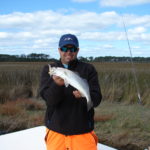
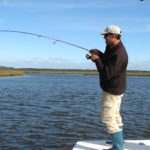
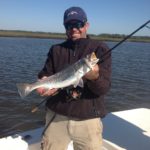
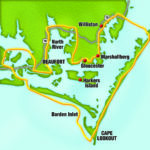

Be the first to comment